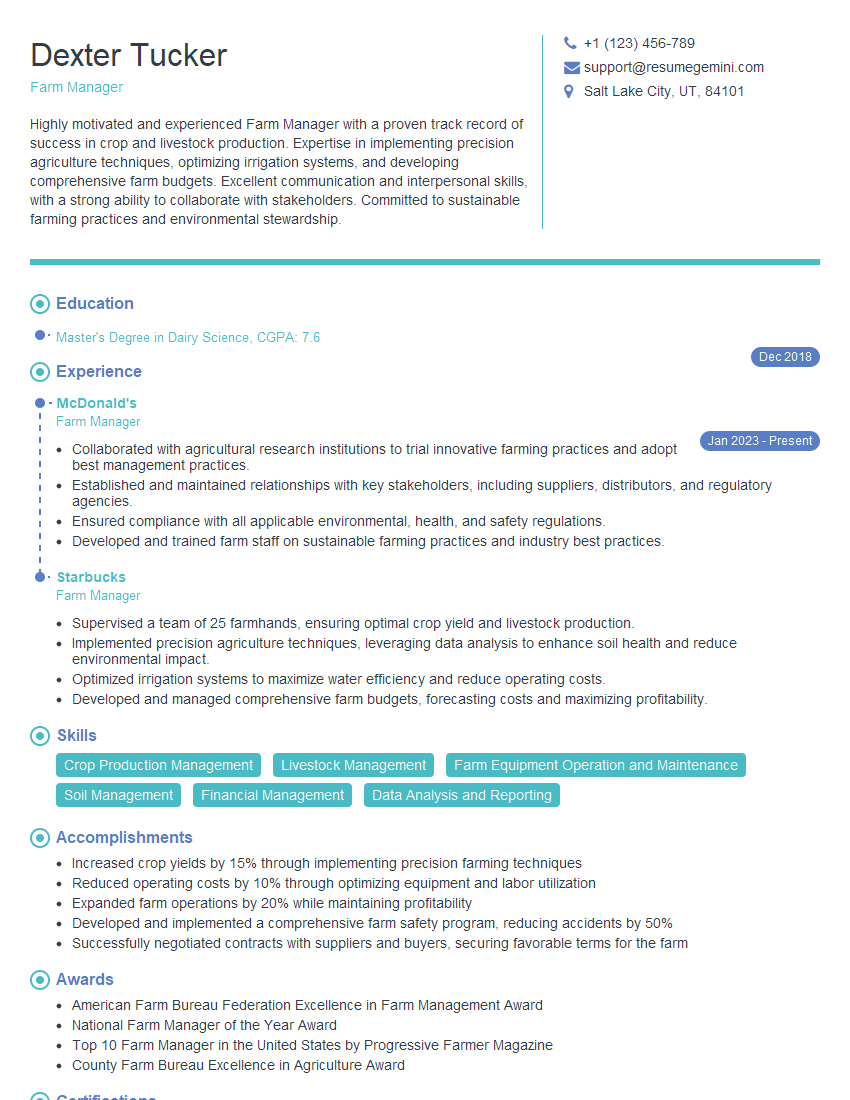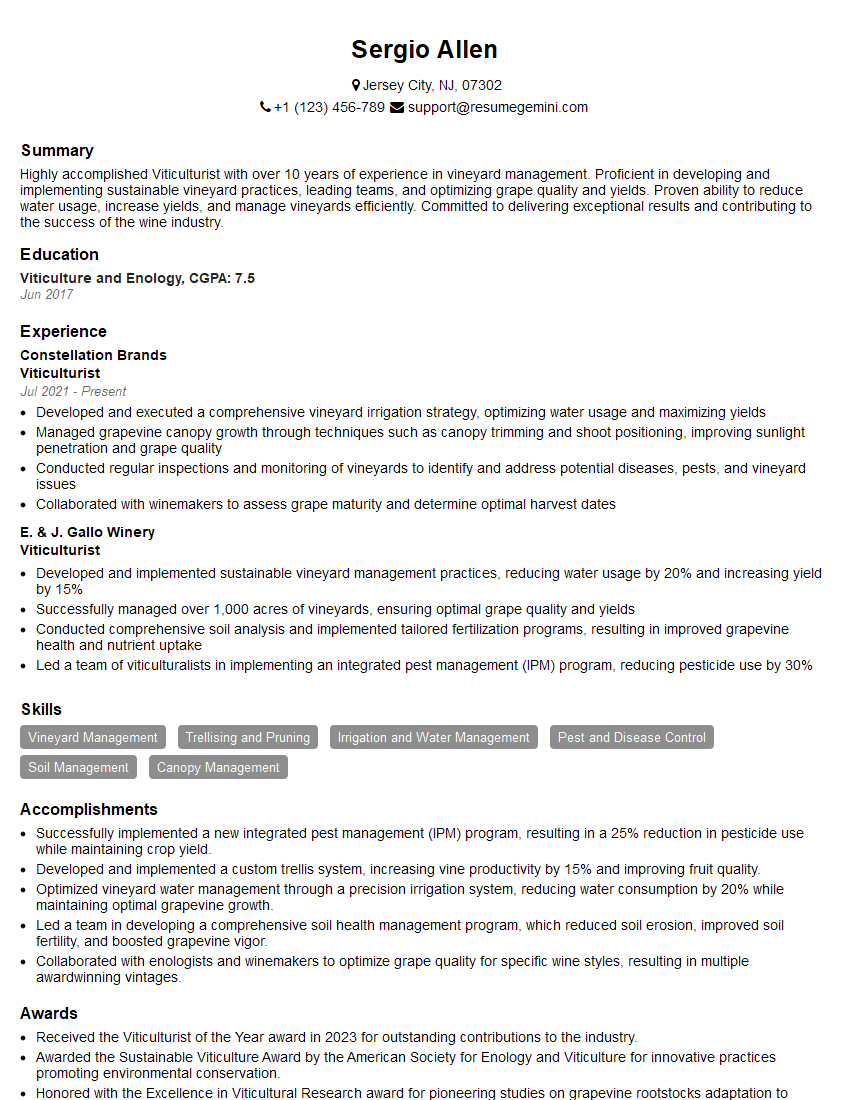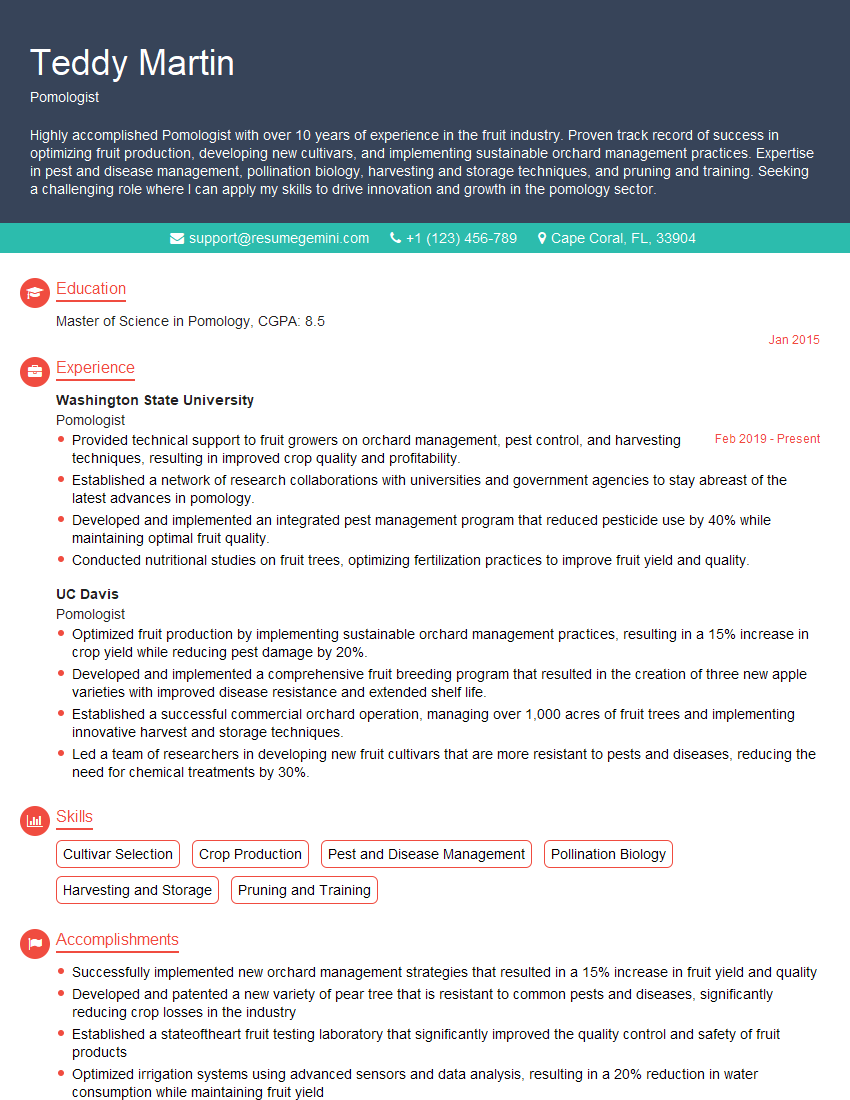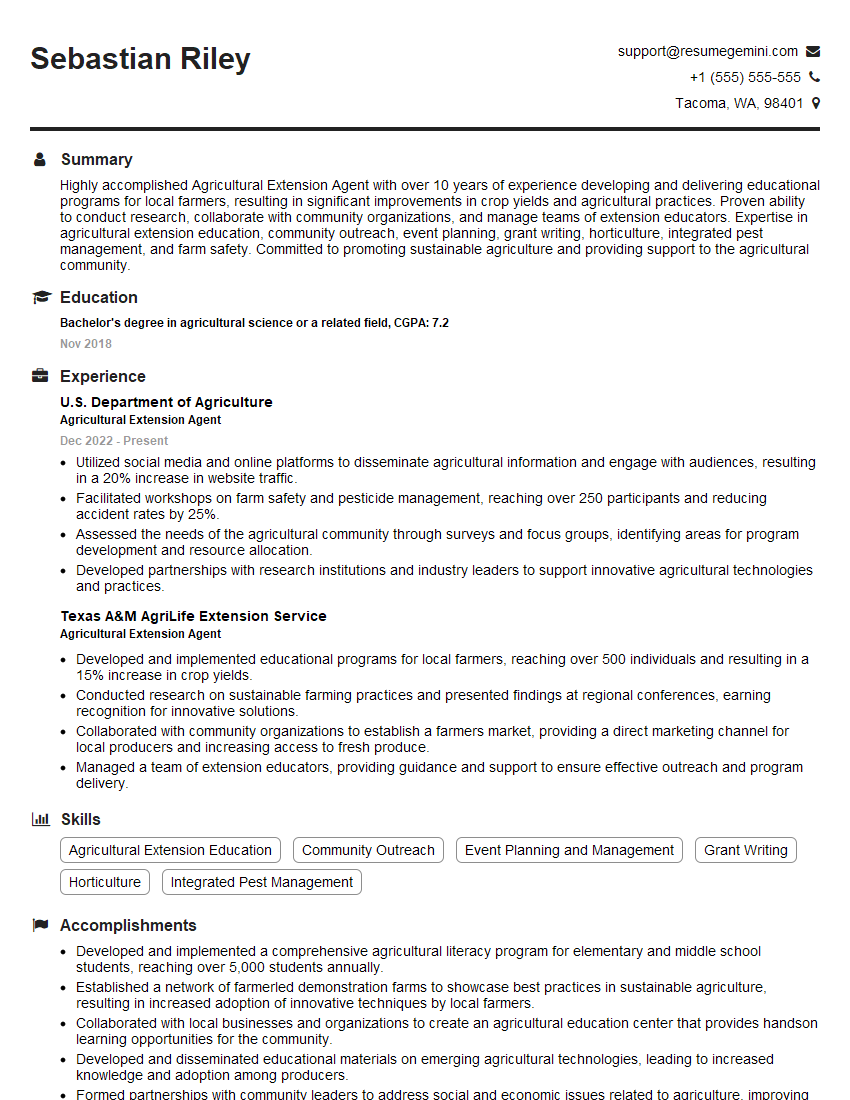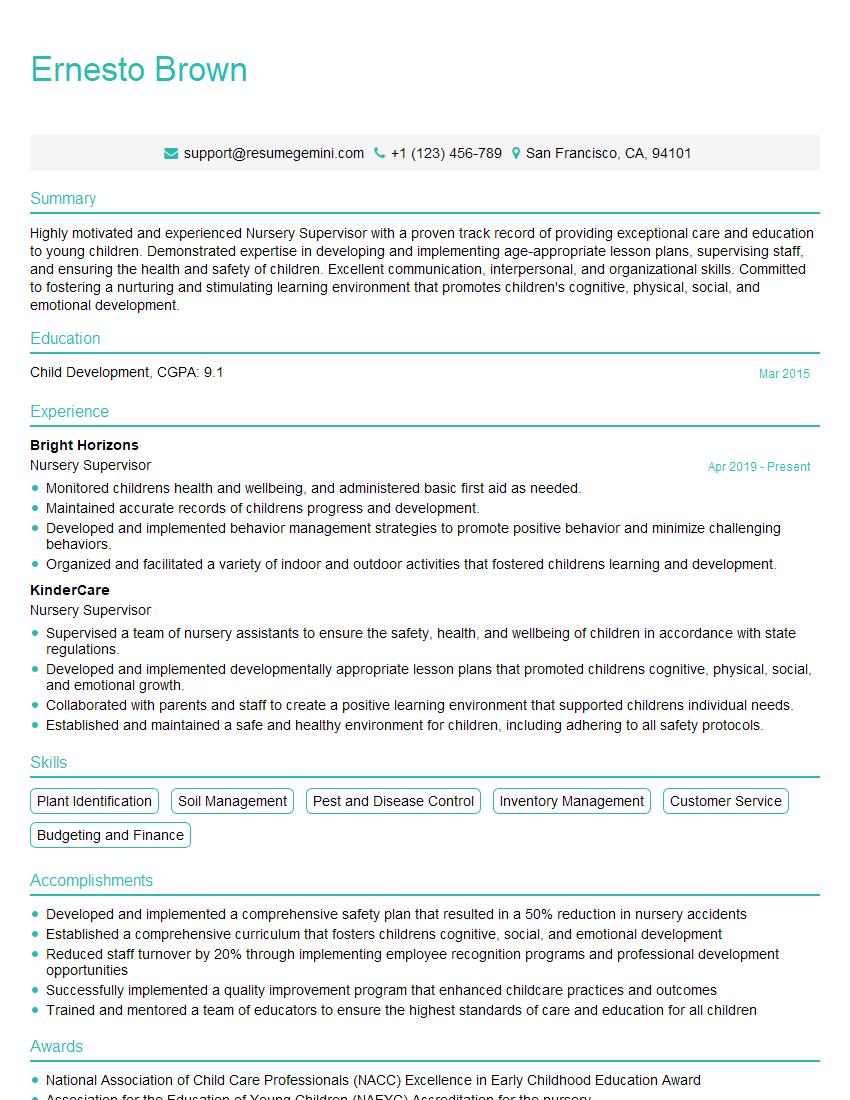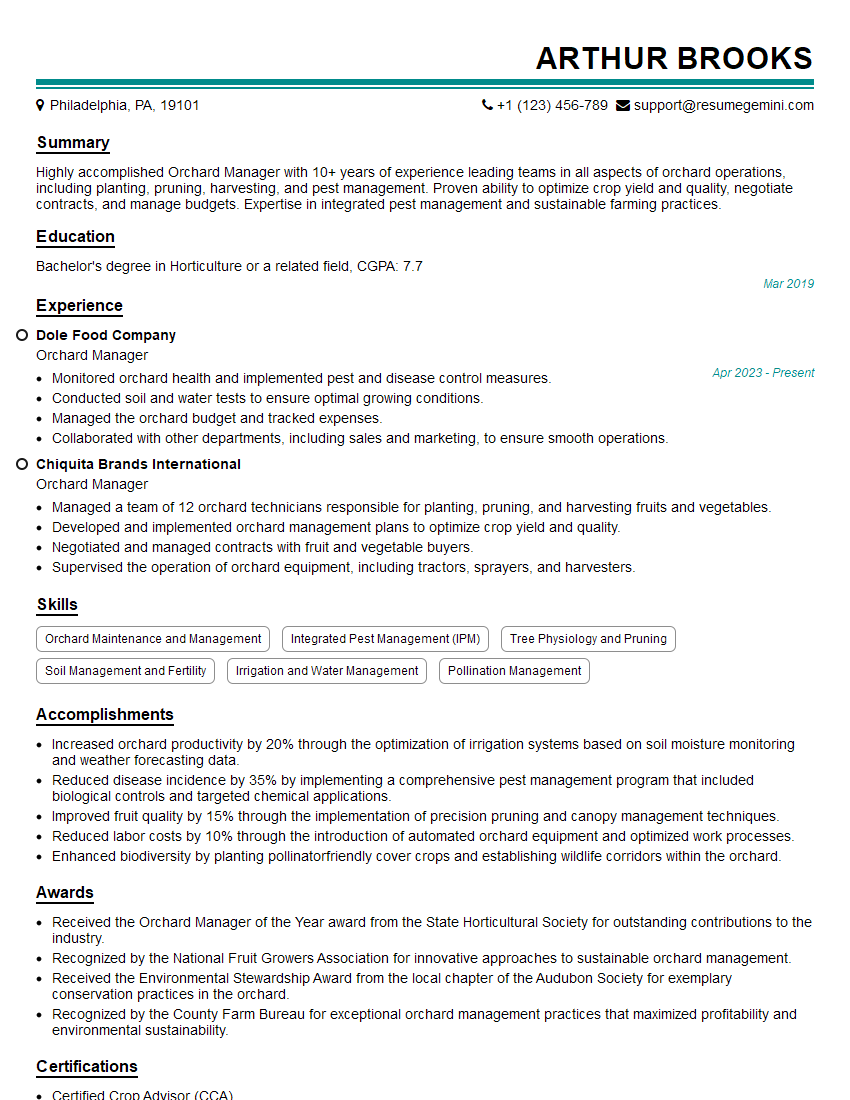Interviews are more than just a Q&A session—they’re a chance to prove your worth. This blog dives into essential Fruit Grafting interview questions and expert tips to help you align your answers with what hiring managers are looking for. Start preparing to shine!
Questions Asked in Fruit Grafting Interview
Q 1. Describe the process of cleft grafting.
Cleft grafting is a simple method ideal for larger rootstocks and scions. Imagine splitting a thick tree branch to insert a smaller twig – that’s the essence of cleft grafting. It’s particularly useful for repairing damaged trees or propagating fruit varieties onto established root systems.
The process involves creating a vertical split in the rootstock, inserting the scion wood with a wedge shape, and securing it tightly to prevent air and moisture loss.
- Step 1: Prepare the Rootstock: Select a rootstock of appropriate size (at least 1 inch in diameter). Make a clean, vertical cut about 2 inches deep.
- Step 2: Prepare the Scion: Choose a healthy scion with two or three buds. Create a wedge shape on one end, making it slightly longer than the rootstock split.
- Step 3: Insert the Scion: Carefully insert the scion wedge into the rootstock split, ensuring that the cambium layers (the actively growing tissue just under the bark) of the rootstock and scion are in close contact. This is crucial for successful grafting.
- Step 4: Secure the Graft: Use grafting tape or rubber bands to tightly secure the scion to the rootstock. This will keep the graft union stable.
- Step 5: Seal the Graft: Apply grafting sealant to the exposed cut surfaces to protect them from drying out and disease.
For example, I once used cleft grafting to repair a mature apple tree damaged by a storm. By grafting a healthy scion onto the remaining trunk, I was able to save the tree and maintain its fruit production.
Q 2. Explain the importance of scion selection in fruit grafting.
Scion selection is paramount in fruit grafting; it determines the fruit quality, yield, and overall success of the graft. Think of the scion as the ‘recipe’ for the final fruit. Choosing the right one is akin to choosing the best ingredients for a delicious dish.
Factors to consider include:
- Variety: Select a scion from a fruit variety with desirable traits like taste, size, disease resistance, and yield. For instance, choosing a disease-resistant apple scion is vital in areas prone to apple scab.
- Health: The scion wood must be healthy and free from diseases or pests. Diseased scion wood will contaminate the entire graft.
- Dormancy: It’s generally recommended to use dormant scion wood, collected during the winter months when the tree is at rest.
- Compatibility: Certain scion and rootstock combinations are more compatible than others. Researching compatible pairings is essential for success.
Poor scion selection can lead to graft failure, poor fruit quality, or even the complete loss of the grafted tree. Always prioritize choosing high-quality scion wood from a reputable source.
Q 3. What are the advantages and disadvantages of whip and tongue grafting?
Whip and tongue grafting is a precise method for joining rootstocks and scions of similar diameter. Imagine interlocking two pieces of wood like a jig-saw puzzle – that’s the basic principle.
Advantages:
- Strong Union: The interlocking tongue creates a strong and secure union, resulting in a robust grafted tree.
- Suitable for Smaller Scions: It’s ideal for smaller diameter rootstocks and scions, which is common when propagating younger trees.
- Faster Healing: The close fit promotes faster callus formation and healing of the graft.
Disadvantages:
- Requires Skill and Precision: The technique demands careful preparation and precision. It’s challenging for beginners.
- Limited Applicability: It’s not suitable for grafting large rootstocks or scions.
- Can be Time-Consuming: The precise cuts can be time-consuming, especially when performing large-scale grafting.
I’ve used whip and tongue grafting successfully on young apple and pear trees. It results in very strong and reliable grafts when done accurately. However, it demands a level of skill and patience not always needed with other grafting methods.
Q 4. How do you choose the appropriate rootstock for a specific fruit variety?
Choosing the right rootstock is critical; it influences the size, growth habit, and disease resistance of the mature tree. It’s like choosing the foundation of a house—a strong foundation ensures a stable and productive structure.
Factors to consider:
- Fruit Variety: Certain rootstocks are more compatible with specific fruit varieties. Check compatibility charts for your specific fruit.
- Desired Tree Size: Dwarfing rootstocks produce smaller trees, suitable for smaller gardens, while vigorous rootstocks create larger trees.
- Soil Conditions: Some rootstocks are better adapted to specific soil types and drainage conditions. For example, a rootstock tolerant to poorly-drained soils is essential if that’s your condition.
- Disease Resistance: Rootstocks resistant to common soilborne diseases can protect the grafted tree from various fungal infections.
- Climate: Rootstock selection must also consider the climate, including cold hardiness and drought tolerance.
For instance, a dwarfing rootstock is ideal for apple trees in a small backyard, while a vigorous rootstock is more appropriate for commercial orchards where larger trees are desirable. Always research rootstock options specific to your region and the intended fruit variety.
Q 5. Explain the process of budding.
Budding, also known as bud grafting, is a technique where a single bud, along with a small piece of bark, is inserted into the rootstock. It’s like transplanting a tiny plant that holds the potential for a whole fruit tree. It’s a common method especially for propagating large numbers of plants.
The process typically involves:
- Preparing the Rootstock: A ‘T’ shaped cut is made in the rootstock bark.
- Preparing the Bud: A bud, with a small shield of bark attached, is carefully removed from the scion wood.
- Inserting the Bud: The bud is inserted into the ‘T’ cut, ensuring the bud’s cambium layer is in close contact with the rootstock’s cambium.
- Securing the Bud: Grafting tape or rubber bands are used to secure the bud.
- Monitoring the Bud: After a few weeks, the tape is carefully removed to check for bud growth.
Budding allows for efficient propagation as a single scion can produce many buds, leading to more grafted plants. It’s especially efficient for situations where space is limited, and numerous plants are needed.
Q 6. What are the common causes of grafting failure?
Grafting failure can stem from various issues, often related to improper technique or environmental factors. Think of it like baking a cake – incorrect ingredients or oven temperature can lead to failure.
Common causes include:
- Incompatible Scion and Rootstock: Attempting to graft incompatible varieties leads to rejection by the rootstock.
- Poor Cambium Contact: The graft union needs close contact between cambium layers for successful fusion. Improper cuts or incorrect positioning prevents this.
- Improper Grafting Technique: Incorrectly made cuts, loose binding, or inadequate sealing can compromise the graft.
- Disease or Pests: Infected scion wood or rootstock can compromise grafting success.
- Environmental Factors: Extreme temperatures, drought, or excessive moisture can harm the graft union before it successfully heals.
- Improper Tool Sterilization: Contamination from tools can introduce diseases.
Addressing these causes, through careful selection, precise technique, and proper environmental conditions, is crucial for achieving successful grafting.
Q 7. How do you prevent disease transmission during grafting?
Preventing disease transmission is vital to the success and longevity of your grafted trees. Contamination can lead to plant death, so we take precautions. This is like carefully sanitizing kitchen tools to avoid cross-contamination.
Strategies to prevent disease transmission:
- Use Healthy Scion Wood: Choose scions from disease-free, vigorous trees.
- Sterilize Tools: Disinfect grafting knives, secateurs, and other tools with a 70% isopropyl alcohol solution or a diluted bleach solution between each graft to prevent the spread of pathogens.
- Select Disease-Resistant Rootstock: Choose rootstocks known for their resistance to common diseases.
- Proper Sanitation: Maintain clean working conditions to minimize the risk of contamination.
- Careful Handling: Avoid handling multiple scions with the same tool without sterilizing in between.
- Monitor Grafts Regularly: Look for any signs of disease or pest infestation. Early detection increases the chances of successful treatment.
By rigorously following these steps, you can significantly minimize the risk of disease transmission and enhance the overall success rate of your grafting efforts.
Q 8. Describe your experience with different grafting techniques (e.g., bark grafting, approach grafting).
Grafting is a fundamental horticultural technique where we unite tissues of two different plants to create a single plant. My experience spans numerous grafting methods. Bark grafting, for instance, is ideal for larger rootstocks, typically used in spring when the bark readily slips. I’ve successfully used this on apple and pear trees, carefully inserting scion wood into a slit in the rootstock bark. Approach grafting, on the other hand, involves uniting two plants while they are still growing in the ground. This technique allows for the development of the graft union before separating the rootstock from its own root system. I find this particularly useful for establishing grafts with difficult-to-handle scions. Other techniques I’m proficient in include whip and tongue grafting, cleft grafting, and side grafting, each chosen based on the rootstock and scion dimensions and the time of year.
- Bark Grafting: Excellent for larger rootstocks in spring when the bark is easily separated.
- Approach Grafting: Useful for delicate scions and allows pre-union development.
- Whip and Tongue: Best for smaller diameter rootstocks and scions, providing excellent alignment.
- Cleft Grafting: Suitable for larger rootstocks with thicker scions.
Q 9. How do you assess the success of a graft union?
Assessing graft success is crucial and involves multiple stages of observation. The first sign is callus formation—a visible swelling at the graft union, indicating that the tissues are knitting together. This usually happens within a few weeks. After a few months, the union should be strong enough to withstand gentle stress testing. Success is ultimately determined by the scion’s growth. New leaves and shoots emerging from the scion wood are clear indicators of a successful graft. Conversely, if the scion withers, blackens, or fails to grow, it signals a failed graft. I carefully inspect each graft for any signs of disease or pest infestation, which can hinder healing. A successful graft will show smooth, integrated tissues, lacking visible seams or breaks between the rootstock and the scion.
Q 10. What are the best times of year to perform different types of grafting?
The optimal timing for grafting varies significantly depending on the fruit type and the specific grafting method. Generally, spring is the most favorable time for many techniques like bark grafting and whip and tongue, coinciding with the active growth phase of the trees. The bark slips more easily during this period, allowing for better union. For stone fruit such as cherries, early spring is preferred because they have a shorter dormant season compared to pome fruit such as apples and pears. Summer grafting is possible for some varieties, but the success rate is often lower. Late summer or early autumn may be suitable for some approach grafting techniques. Timing is critical; performing a graft when the cambium layer (the actively growing tissue) is functioning optimally maximizes the chances of a successful union.
Q 11. Describe your experience with grafting different fruit types (e.g., apples, pears, cherries).
My experience encompasses grafting a wide range of fruit types. Apples and pears are relatively straightforward, though selecting compatible rootstocks is essential to ensure good growth and disease resistance. For example, M.9 is a popular dwarfing rootstock for apples, whereas quince A is commonly used for pears. Cherry grafting requires more precision due to the delicate nature of cherry wood, often opting for techniques like whip and tongue grafting. I’ve had notable success with various apple cultivars like ‘Fuji’ and ‘Gala’ grafted onto various rootstocks, and with pear cultivars like ‘Bartlett’ and ‘Anjou.’ Each fruit type presents unique challenges related to timing, compatibility, and grafting technique, making the experience incredibly diverse and enriching.
Q 12. How do you care for grafted trees post-grafting?
Post-grafting care is as vital as the grafting process itself. After grafting, I protect the graft union from the elements using grafting tape or sealant to prevent desiccation. Regular watering is crucial to ensure that the scion and rootstock receive adequate moisture for optimal growth and healing. Newly grafted trees should be protected from excessive sunlight, strong winds, and extreme temperatures. Regular monitoring for pests and diseases is necessary to prevent infestations that could compromise the graft’s healing. Pruning to remove competing shoots may be necessary to direct growth toward the scion, this needs to be done carefully to avoid damaging the graft union. Consistent monitoring and appropriate adjustments based on the health of the tree are essential for a successful outcome.
Q 13. How do you identify compatible rootstock and scion combinations?
Rootstock and scion compatibility is paramount for successful grafting. Incompatible combinations will result in a weak or failed graft union. Compatibility is influenced by factors such as genetic relationships, disease resistance, growth habit, and ultimate size of the tree. I use established grafting charts and consult with colleagues to ensure compatibility. For example, certain rootstocks are more compatible with specific apple cultivars. Experience has taught me to carefully consider the desired growth characteristics (e.g., tree size, yield) when selecting rootstock-scion combinations. Thorough research and attention to detail in selecting compatible partners greatly improve the chances of successful grafting and long-term tree health.
Q 14. Explain the concept of cultivar propagation through grafting.
Cultivar propagation through grafting is the process of using grafting to create genetically identical copies (clones) of a desirable fruit tree. It’s an essential technique for maintaining specific traits of a particular cultivar. For example, if a particular apple variety demonstrates exceptional fruit quality, disease resistance, or a unique flavor profile, grafting allows for the widespread propagation of these attributes without the variability associated with seed propagation. Grafting preserves the exact genetic material of the original tree, ensuring consistency in the offspring trees. This is significantly advantageous in commercial fruit production, maintaining consistent quality across large orchards. This method effectively ensures that the desirable traits are replicated in the new trees, contributing to fruit production stability and predictability.
Q 15. What is the importance of proper sanitation in grafting?
Proper sanitation in grafting is paramount to preventing the transmission of diseases and promoting successful union between the scion and rootstock. Think of it like performing surgery – you wouldn’t operate without sterilizing your instruments! Contamination can lead to graft failure, weakening of the tree, and the spread of harmful pathogens throughout your orchard.
- Before grafting: Sterilize all tools, including knives, shears, and budding tools, using a solution of 70% isopropyl alcohol or a commercial disinfectant. Allow them to air dry completely to avoid introducing moisture which can encourage fungal growth.
- During grafting: Clean the cut surfaces of both the scion and rootstock with a clean, sharp blade to remove any dirt or debris. Avoid touching the cut surfaces with your bare hands. Gloves are essential.
- After grafting: Protect the graft union from the elements using grafting tape or sealant. This prevents pathogen entry and reduces the risk of infection. Regularly inspect the grafts for any signs of disease or infection.
For example, I once had a batch of apple grafts fail due to neglecting to sterilize my grafting knife. A previously unseen fungal infection spread rapidly, causing significant losses.
Career Expert Tips:
- Ace those interviews! Prepare effectively by reviewing the Top 50 Most Common Interview Questions on ResumeGemini.
- Navigate your job search with confidence! Explore a wide range of Career Tips on ResumeGemini. Learn about common challenges and recommendations to overcome them.
- Craft the perfect resume! Master the Art of Resume Writing with ResumeGemini’s guide. Showcase your unique qualifications and achievements effectively.
- Don’t miss out on holiday savings! Build your dream resume with ResumeGemini’s ATS optimized templates.
Q 16. Describe your experience troubleshooting grafting issues.
Troubleshooting grafting issues requires a keen eye for detail and a systematic approach. I’ve encountered various problems over the years, from incompatibility issues to environmental factors hindering graft take. My approach involves careful observation, record-keeping, and a methodical process of elimination.
For instance, if a graft fails to unite, I first check for signs of disease or insect damage. If none are present, I evaluate the quality of the scion and rootstock wood – were the cuts clean? Was the cambium layer properly aligned? I then consider environmental factors like temperature, moisture levels, and sunlight exposure. Insufficient moisture, for example, can significantly impede the healing process. Sometimes, the issue may be incompatibility between the scion and rootstock; a thorough understanding of rootstock characteristics is crucial to prevent this.
I maintain detailed records of each graft, noting the date, type of graft, scion and rootstock cultivars, and any observations during the process. This helps me identify recurring problems and refine my techniques over time. I often take photographs to document the issue and its progression, and to compare successes and failures.
Q 17. How do you manage pests and diseases in grafted trees?
Managing pests and diseases in grafted trees requires a multi-pronged approach that combines preventative measures and targeted treatments. The goal is to protect the graft union, which is the most vulnerable point during the healing process.
- Preventative measures: Selecting disease-resistant rootstocks, practicing proper sanitation, and ensuring good air circulation within the orchard can significantly reduce pest and disease pressure. Pruning to improve airflow and sunlight penetration helps.
- Targeted treatments: Regular monitoring for signs of pests and diseases is crucial. Early detection allows for prompt intervention, limiting the damage and minimizing the need for harsh chemicals. Depending on the specific pest or disease, various control methods can be employed, including biological control agents, horticultural oils, and targeted pesticides used only as a last resort.
For example, I regularly monitor for signs of fire blight in my apple trees, a bacterial disease that can severely damage grafted trees. Early detection and removal of infected branches prevents widespread infestation.
Q 18. What are some common grafting tools and their uses?
Several tools are essential for successful grafting. The choice depends on the specific grafting technique employed.
- Grafting knife: A sharp knife is crucial for making precise and clean cuts. A high-quality knife with a replaceable blade is ideal for maintaining sharpness.
- Budding knife: Used for specific grafting techniques like T-budding and chip budding. It features a curved blade and a small hook for lifting bark.
- Grafting saw: Used for larger branches, allowing for clean cuts on thicker scions and rootstocks.
- Grafting tape or sealant: Secures the scion and rootstock together, protecting the union from the elements and pathogens.
- Pruning shears: For preparing the rootstock and scion before grafting.
Q 19. How do you maintain the sharpness of grafting tools?
Maintaining the sharpness of grafting tools is critical for making clean cuts, which is essential for successful grafting. A dull tool can crush plant tissues, hindering the union and increasing the risk of infection.
- Regular sharpening: Sharpen the tools regularly, after each use or after several grafts, using a honing steel or a sharpening stone.
- Proper storage: Store the tools in a dry, clean place to prevent rust and corrosion. Sheaths or protective covers are ideal.
- Professional sharpening: For particularly fine tools, professional sharpening may be beneficial to ensure optimal performance and longevity.
Think of it like a surgeon’s scalpel – precision is paramount!
Q 20. What are the safety precautions associated with grafting?
Safety precautions are crucial when working with grafting tools. These sharp instruments can cause serious injuries.
- Wear appropriate safety gear: Always wear gloves, safety glasses, and closed-toe shoes to protect yourself from cuts and other injuries.
- Handle tools carefully: Keep tools sharp to reduce the force required for cutting. Avoid reaching or making cuts in awkward positions.
- Proper storage: Store tools properly, out of reach of children and other individuals who may not be aware of their potential danger.
- First-aid awareness: Be prepared to handle any injuries, having a first-aid kit on hand.
Q 21. How do you prepare scion wood for grafting?
Preparing scion wood is a critical step in successful grafting. The quality of the scion wood directly impacts the success of the graft.
- Selection: Choose healthy, disease-free scions from vigorous, productive trees. The wood should be dormant or semi-dormant, depending on the grafting method.
- Collection: Collect scions during the dormant season (late fall or winter) before bud break. Store them in a cool, moist environment to prevent desiccation.
- Preparation: Before grafting, prepare the scions by cutting them into appropriate lengths with clean, precise cuts. The cut surface should be smooth and free of ragged edges.
- Storage: Proper storage of scion wood is essential. Store them in a cool, moist, and well-ventilated environment, such as a refrigerator or a cold frame. They can be wrapped in moist paper towels or stored in plastic bags with slightly damp peat moss.
Properly prepared scion wood is the key to a successful graft.
Q 22. What is the role of grafting in improving fruit production?
Grafting plays a crucial role in enhancing fruit production by combining the desirable traits of two different plants. Imagine you have a rootstock known for its disease resistance and strong root system, and a scion (the upper part of the graft) bearing exceptional fruit quality and yield. Grafting unites these characteristics, resulting in a tree that’s both productive and resilient. This is particularly beneficial for propagating superior cultivars that might not reproduce reliably through seed propagation, maintaining consistent fruit quality across generations.
- Increased Yield: Grafting can lead to significantly higher fruit yields compared to growing the scion on its own roots.
- Improved Fruit Quality: Combining superior fruit characteristics with robust rootstocks leads to larger, more flavorful, and better-looking fruit.
- Disease and Pest Resistance: Rootstocks can offer resistance to certain diseases or pests, protecting the entire tree, including the fruit-bearing scion.
- Adaptability to Soil and Climate: Choosing appropriate rootstocks allows growers to cultivate specific varieties in areas where they might not otherwise thrive.
Q 23. How do you address incompatibility issues in grafting?
Incompatibility in grafting occurs when the cambium layers (the actively growing tissues just beneath the bark) of the scion and rootstock fail to fuse properly. This can lead to graft failure. Addressing incompatibility involves several strategies:
- Careful Selection of Rootstock and Scion: Using compatible combinations is crucial. Extensive research and knowledge of grafting compatibility charts are essential for success. Certain rootstocks are known to be more compatible with specific scions.
- Intermediary Grafting: If direct grafting is incompatible, an intermediary graft can be used. This involves grafting a compatible cultivar onto the rootstock first, then grafting the desired scion onto the intermediary cultivar.
- Improved Grafting Techniques: Precise alignment of the cambium layers during grafting is crucial for successful union. Proper preparation, using sharp tools, and ensuring close contact are vital.
- Environmental Considerations: Factors such as temperature, humidity, and proper aftercare significantly influence the graft’s success. Protecting the graft union from environmental stressors is crucial.
For instance, some apple varieties are notoriously difficult to graft onto certain rootstocks. Careful selection and possibly the use of an intermediary can overcome this issue.
Q 24. Explain the difference between top grafting and root grafting.
Top grafting and root grafting are two distinct methods used for grafting fruit trees. They differ primarily in the location of the graft union.
- Top Grafting: In this method, the scion is grafted onto the existing top of an established tree. This is useful for rejuvenating older trees or changing the variety of fruit produced by an existing tree. It typically involves removing a portion of the existing branches and grafting new scions onto the remaining framework. This might be done using methods like cleft grafting or bark grafting, depending on the size of the branches.
- Root Grafting: Root grafting involves grafting scions directly onto the roots of a plant. This method is often used for propagating large numbers of plants quickly and efficiently, particularly in nurseries. It’s also valuable for rootstock propagation to ensure good root system characteristics are preserved.
Think of it this way: top grafting is like adding a new chapter to an existing story, while root grafting is like starting a new story with a strong foundation.
Q 25. How does grafting contribute to fruit quality?
Grafting significantly impacts fruit quality. By combining desirable traits from different varieties, you can enhance several aspects of the fruit.
- Size and Shape: The scion’s genetics will largely dictate the size and shape of the fruit. Grafting onto a suitable rootstock can further improve fruit uniformity.
- Flavor and Aroma: The scion’s genetic contribution significantly impacts the flavor and aroma profiles of the fruit. Grafting can lead to superior taste, sweetness, and fragrance compared to using the scion alone.
- Color and Appearance: Fruit color, skin texture, and overall appearance are largely determined by the scion. Grafting ensures consistency and allows growers to obtain desirable fruit characteristics.
- Storage Quality: Certain scions are more tolerant to bruising and have longer storage shelf life than others, contributing to marketability.
For example, grafting a specific apple cultivar known for its exceptional flavor and crispness onto a rootstock resistant to fire blight will result in apples with superior quality and extended storage life.
Q 26. What is your experience with using grafting wax or sealant?
Grafting wax or sealant is an essential part of the grafting process. It acts as a protective barrier, preventing the entry of pathogens and minimizing water loss from the graft union. My experience encompasses using a range of grafting waxes and sealants, from traditional paraffin-based products to more modern formulations including those containing fungicides. The choice of sealant often depends on the specific grafting technique, the climate, and the species of tree.
Proper application is crucial; a thorough and airtight seal is necessary to ensure successful graft union and minimize the risk of disease. I’ve seen cases where inadequate sealing has led to graft failure due to desiccation or infection, highlighting the importance of this step.
Q 27. Describe a challenging grafting experience you overcame.
One of my most challenging grafting experiences involved attempting to graft a particularly temperamental pear cultivar (‘Comice’) onto a quince rootstock in a hot, dry summer. The high temperatures and low humidity created ideal conditions for desiccation of the graft union, and the ‘Comice’ pear is known to be somewhat difficult to graft.
To overcome this, I implemented several strategies: I pre-treated the scions by storing them in a cool, humid environment to minimize water loss. I performed the grafting early in the morning to avoid peak heat, and I carefully wrapped the grafts in individual plastic sleeves to create a microclimate with higher humidity. I also frequently misted the grafts with water to prevent drying. While the success rate wasn’t perfect, this multi-pronged approach dramatically improved the survival rate compared to previous attempts without those modifications. I learned the importance of understanding environmental factors in grafting and the value of employing multiple mitigation strategies.
Q 28. How do you stay up-to-date with the latest advancements in grafting techniques?
Staying current with advancements in grafting techniques requires a multi-faceted approach.
- Professional Conferences and Workshops: Attending horticultural conferences and specialized grafting workshops allows me to learn about new techniques, grafting materials, and research findings from leading experts in the field.
- Peer-Reviewed Journals and Publications: Regularly reading scientific journals and research papers keeps me informed about the latest research on grafting compatibility, techniques, and the physiological aspects of graft union formation.
- Online Resources and Professional Networks: Accessing online resources and participating in online forums and professional networks provides valuable opportunities for knowledge exchange and learning from other practitioners.
- Collaboration and Mentorship: Collaborating with experienced horticulturalists and seeking mentorship from experienced grafters provides practical insights and access to a wealth of shared knowledge.
By combining these methods, I maintain a strong understanding of best practices and emerging technologies in the field of fruit grafting.
Key Topics to Learn for Your Fruit Grafting Interview
- Scion and Rootstock Selection: Understanding compatibility, desired characteristics (e.g., disease resistance, fruit quality), and appropriate grafting techniques for different combinations.
- Grafting Techniques: Mastering various methods such as whip and tongue, cleft grafting, bark grafting, and budding, including their respective advantages and disadvantages for different fruit species and situations.
- Graft Union Formation and Healing: Knowing the physiological processes involved in successful graft union development, factors affecting healing (e.g., environmental conditions, proper technique), and identifying signs of successful or unsuccessful grafts.
- Practical Application in Orchard Management: Demonstrate understanding of implementing grafting in commercial orchards, including considerations for scale, efficiency, and post-grafting care.
- Troubleshooting Grafting Issues: Diagnosing common problems such as graft incompatibility, failure to heal, and disease transmission, and explaining preventative measures and corrective actions.
- Propagation and Nursery Practices: Understanding the role of grafting in plant propagation within a nursery setting, including stock preparation and post-grafting management of young plants.
- Advanced Grafting Techniques: Familiarity with more specialized techniques (e.g., topworking, bridge grafting) and their applications in specific orchard scenarios.
Next Steps: Grow Your Career with Fruit Grafting Expertise
Mastering fruit grafting opens doors to exciting opportunities in horticulture, agriculture, and research. To maximize your job prospects, a well-crafted, ATS-friendly resume is crucial. ResumeGemini can help you build a professional resume that highlights your skills and experience effectively. We offer examples of resumes tailored specifically to fruit grafting professionals, giving you a head start in your job search. Take advantage of this valuable resource to present yourself in the best possible light and secure your dream role.
Explore more articles
Users Rating of Our Blogs
Share Your Experience
We value your feedback! Please rate our content and share your thoughts (optional).
What Readers Say About Our Blog
Hello,
We found issues with your domain’s email setup that may be sending your messages to spam or blocking them completely. InboxShield Mini shows you how to fix it in minutes — no tech skills required.
Scan your domain now for details: https://inboxshield-mini.com/
— Adam @ InboxShield Mini
Reply STOP to unsubscribe
Hi, are you owner of interviewgemini.com? What if I told you I could help you find extra time in your schedule, reconnect with leads you didn’t even realize you missed, and bring in more “I want to work with you” conversations, without increasing your ad spend or hiring a full-time employee?
All with a flexible, budget-friendly service that could easily pay for itself. Sounds good?
Would it be nice to jump on a quick 10-minute call so I can show you exactly how we make this work?
Best,
Hapei
Marketing Director
Hey, I know you’re the owner of interviewgemini.com. I’ll be quick.
Fundraising for your business is tough and time-consuming. We make it easier by guaranteeing two private investor meetings each month, for six months. No demos, no pitch events – just direct introductions to active investors matched to your startup.
If youR17;re raising, this could help you build real momentum. Want me to send more info?
Hi, I represent an SEO company that specialises in getting you AI citations and higher rankings on Google. I’d like to offer you a 100% free SEO audit for your website. Would you be interested?
Hi, I represent an SEO company that specialises in getting you AI citations and higher rankings on Google. I’d like to offer you a 100% free SEO audit for your website. Would you be interested?
good
